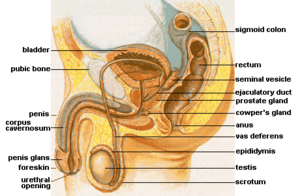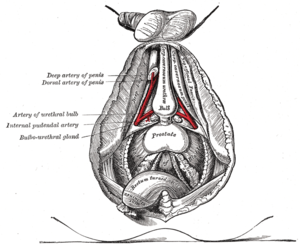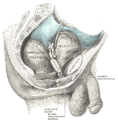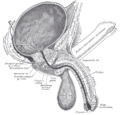- Bulbourethral gland
-
Bulbourethral gland 
Male Anatomy 
The deeper branches of the internal pudendal artery. (Bulbourethral gland labeled at center left.) Latin glandulæ bulbourethrales Gray's subject #264 1253 Artery Artery of the urethral bulb Precursor Urogenital sinus MeSH Bulbourethral+Glands A bulbourethral gland, also called a Cowper's gland for anatomist William Cowper, is one of two small exocrine glands present in the reproductive system of human males. They are homologous to Bartholin's glands in females.
Contents
Location
Bulbourethral glands are located posterior and lateral to the membranous portion of the urethra at the base of the penis, between the two layers of the fascia of the urogenital diaphragm, in the deep perineal pouch. They are enclosed by transverse fibers of the sphincter urethrae membranaceae muscle.
Structure
The bulbourethral glands are compound tubulo-alveolar glands, each approximately the size of a pea. They are composed of several lobules held together by a fibrous covering. Each lobule consists of a number of acini, lined by columnar epithelial cells, opening into a duct that joins with the ducts of other lobules to form a single excretory duct. This duct is approximately 2.5 cm long and opens into the urethra at the base of the penis. The glands gradually diminish in size with advancing age.[1]
Function
During sexual arousal each gland produces a clear, viscous secretion known as pre-ejaculate. This fluid helps to lubricate the urethra for spermatozoa to pass through, neutralizing traces of acidic urine in the urethra,[2] and helps flush out any residual urine or foreign matter. It is possible for this fluid to pick up sperm, remaining in the urethral bulb from previous ejaculations, and carry them out prior to the next ejaculation. The Cowper's gland also produces some amount of prostate-specific antigen (PSA), and Cowper's tumors may increase PSA to a level that makes prostate cancer suspected.[citation needed]
Gallery
See also
Notes
- ^ Gray's Anatomy, 38th edn, p 1861.
- ^ Chughtai, Bilal; Ahmed Sawas, Rebecca L. O'Malley, Rohan R. Naik, S. Ali Khan, Srinivas Pentyala (April 2005). "A Neglected Gland: A Review of Cowper's Gland". International Journal of Andrology (Blackwell Publishing) 28 (2): 74–7. doi:10.1111/j.1365-2605.2005.00499.x. ISSN 0105-6263. PMID 15811067. http://www3.interscience.wiley.com/journal/118692977/abstract.
Male reproductive system (TA A09.3–4, TH H3.07.02, GA 11.1236) Internal layers (Tunica vaginalis, Tunica albuginea, Tunica vasculosa testis) · Appendix · Mediastinum · Lobules · Septa · Leydig cell · Sertoli cell · Blood-testis barrierOtherSeminiferous tubules (Tubuli seminiferi recti, Rete testis, Efferent ducts) · Epididymis (Appendix, Stereocilia) · Paradidymis · Spermatic cord · Vas deferens (Ampulla) · Ejaculatory ductAccessory
glandsExternal root (Crus, Bulb, Fundiform ligament, Suspensory ligament) · body (Corpus cavernosum, Corpus spongiosum) · glans (Foreskin, Frenulum, Corona) · fascia (superficial/subcutaneous, deep/Buck's) · Tunica albuginea · Septum of the penisCategories:- Glands
- Exocrine system
- Male reproductive system
Wikimedia Foundation. 2010.



